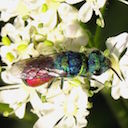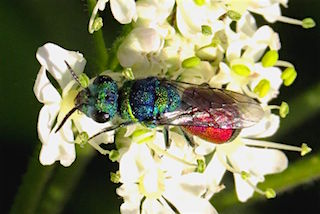 What a jewel of an insect! This Ruby-tailed Wasp was spotted at Poltesco.
What a jewel of an insect! This Ruby-tailed Wasp was spotted at Poltesco.
Photo: Andy Pay
Scientific name: Chrysis ruddii
What to look for:
• Colouring and appearance: Metallic colours of blue, bronze and green with a red abdomen.
• Size: Length to 10 mm.
• Where: Across Europe and Asia Minor. Usually found by the coast, shingle banks, soft cliffs.
• When: Flight time is May to September.
 The name Ruby-tailed Wasp is given to more than one species of this genus of solitary wasps, and they can be difficult to tell apart. Chrysis hirsuta and C. fulgida are Priority Species in the UK Biodiversity Action Plan. Chrysis ruddii is not currently classified as at risk, but recent declines suggest this status might need revising.
The name Ruby-tailed Wasp is given to more than one species of this genus of solitary wasps, and they can be difficult to tell apart. Chrysis hirsuta and C. fulgida are Priority Species in the UK Biodiversity Action Plan. Chrysis ruddii is not currently classified as at risk, but recent declines suggest this status might need revising.
This gorgeous, jewel-bright insect is in fact a parasite of another solitary wasp – Ancistrocerus oviventris – and the apparent decline in C. ruddii goes hand in hand with a decline in A. oviventris. The Ruby-tailed Wasp searches for a nest of its host species, and lays its eggs next to those of the host after carefully checking the adult is absent. On returning, the host wasp seals up the nest, in complete ignorance of the ‘cuckoo’ eggs inside. After hatching, the parasite larvae eat the larvae of the unfortunate host species, and then emerge in spring of the next year, ready to begin the next cycle.
Chrysis ruddii has generally been considered a variety of C. ignita (the Buglife article, link below, assumes this), but is probably a separate species given the close coincidence in the decline of host and parasite.
Did you know…?
…There are more than 1000 members of the Chrysis genus.
…The genus name Chrysis is from the Greek for ‘gold vessel’ or ‘gold-embroidered dress’, in reference to the metallic hues of the wasps.
Published: June 2016
Author: Amanda Scott
Photos: Andy Pay
